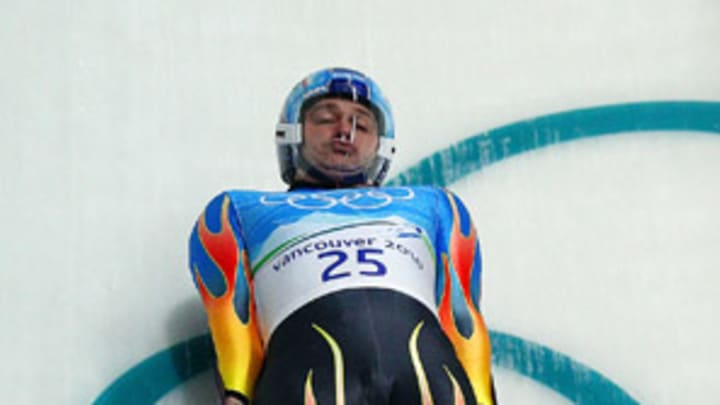Luge is safe? One study says it is

Luge is a dangerous sport in which accidents happen. That was the refrain from luger after luger when asked about the death of Georgia's Nodar Kumaritashvili, who was traveling at 88 mph when he flew off the last turn of the Olympic track in Whistler during a training run on Friday and was killed.
But the sport's athletes will be the first to tell you that they are driving technicians rather than adrenaline junkies, and that they don't consider luge to be overly risky. Amidst the entirely appropriate shock at the death of a young athlete, that fact has been lost that in the hands -- and feet -- of masters, luge is relatively safe.
A peer-reviewed scientific study of luge injuries, a 1997 paper in the American Journal of Sports Medicine, analyzed runs from 1985 through '92 on the Lake Placid course, a track considered by sliders to be trickier than Whistler. It concluded that luge's injury rates were "comparable with recreational skiing."
The study analyzed 57,244 competitive runs by men and women ages 12 to 35, and recorded 407 injuries. The vast majority of those were bruises, scrapes and muscle strains. (Luge is rough on the back and neck muscles). A mere 10 injuries over the seven years were serious enough -- there were some cases of broken bones -- that the athlete missed a week or more of practice. Lugers were more likely to get hurt while away from the track, doing things like carrying their sleds, than to be seriously injured on the track.
The grand total of concussions was 10. By comparison, a six-year study of the NFL found, by conservative estimate, that a concussion occurred about every two games. That would mean that, since there are 16 games on opening NFL weekend, pro football experiences seven years of Lake Placid brain injuries by the second week of a season. In boxing, moreover, the entire goal of the competition is to so damage the opponent that he loses motor control and is unable to stand. And as Canadian luge coach Wolfgang Staudinger pointed out, the speeds of race cars are not reduced every time a driver crashes and dies -- nor, for that matter, are speed limits on roads, where 37,261 people in the U.S. were killed in crashes in 2008.
Dr.Robert Cummings, the author of the Lake Placid study, does note that different tracks have different hazards. (An orthopedic surgeon and former competitive luger, Cummings says he never suffered a serious injury). Much was made of the speeds at Whistler, the world's fastest track, where a German slider topped 95 mph last year. And yet officials from the international luge federation note that Whistler's crash statistics are in line with those at other tracks around the world. Across 30,000-plus runs in bobsled, luge and skeleton over the past three years, Whistler had seen 340 crashes, none fatal before last Friday. Lugers and coaches at these Games said they've never seen an athlete fly entirely off the course as Kumaritashvili did. The Georgian's crash was a terrible, freak occurrence. "Everything came together at the same time," said Tony Benshoof, a U.S. luger who finished eighth on Sunday, "but there are places on every track where that could feasibly happen." Essentially, though, it doesn't.
That isn't to say that the modifications in Whistler -- the ice on curve 16 was shaved to make it harder for sleds to go up the wall, a new retaining wall was put in place and the men's start was lowered to that of the women -- are not perfectly prudent. Nor do they significantly alter the competition in the eyes of most observers, for whom the sport looks much the same at 80 mph as at 90. Perhaps retaining walls should be put along each curve at every track in the world, and even the athletes who were upset at the lower starting spot were quick to say that the luge federation had to show the world how serious it is about safety.
What happened to Nodar Kumaritashvili was a tragedy so deeply affecting that athletes who should have been reveling in the realization of their Olympic dreams were frequently choking back tears. Still, they agreed that the rush to characterize every luge run as a life-and-death gamble is a conclusion reserved for those who only started following the sport on that tragic Friday.
It's a long-accepted practice in Olympic luge that the home country gains an advantage from extra practice time on its own course. Because of the change in the start house at Whistler, however, Canada's advantage "melted like snow in the rain," said Staudinger, who was noticeably angered by the move. The course, he maintained, is only dangerous "for countries that approach it like tourists." Indeed, the tiny Georgian team did not take advantage of every training opportunity offered at Whistler. During the first week in January, for instance, the course was open for extra training to all lugers ranked lower than 30th.
Staudinger felt that Kumaritashvili never should have been at Vancouver in the first place. The Olympic competition is intended for the top 40 lugers in the world, but for various reasons some of those athletes don't make the trip, which opens the door for lower-ranked sliders. For example, Staudinger noted that Gregory Carigiet, a Swiss luger who was ranked 19th in the world, did not qualify based on Switzerland's own internal standards.
Kumaritashvili, ranked 44th, would not have been competing at Whistler had every eligible slider ahead of him come to the Games. "That is a loophole we need to change," Staudinger said. He added that he expects the international luge federation to take up that issue in the spring.
